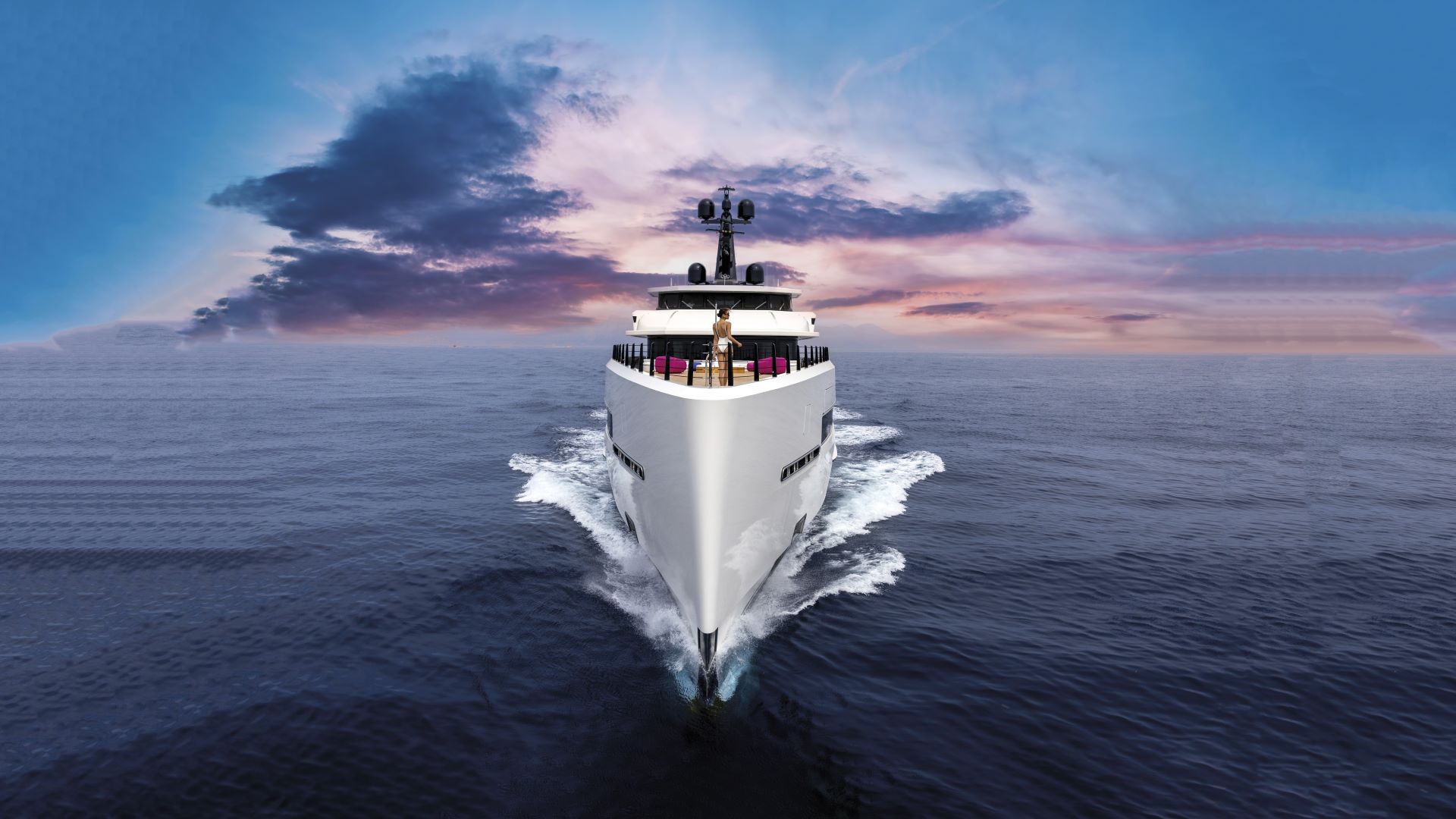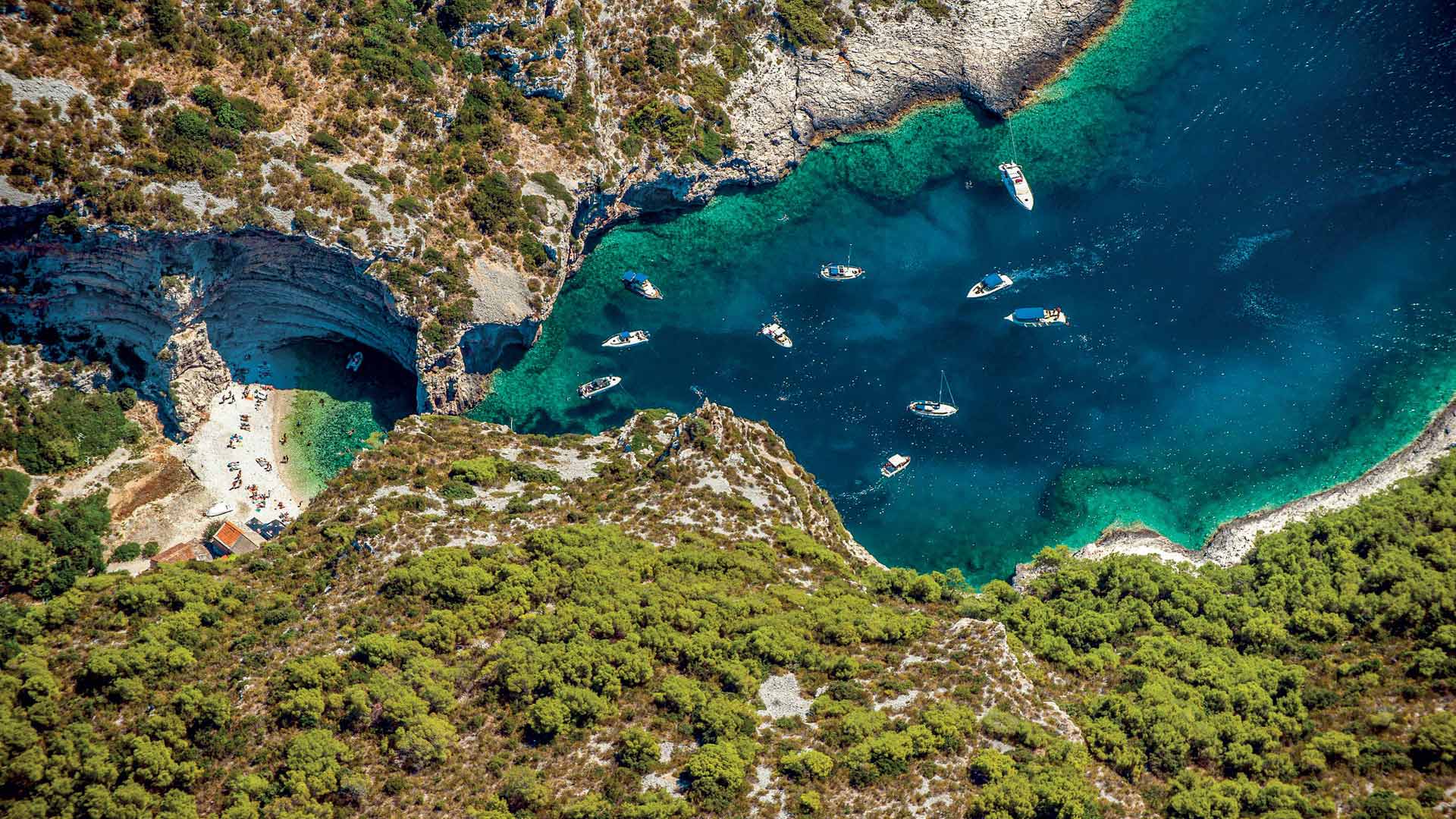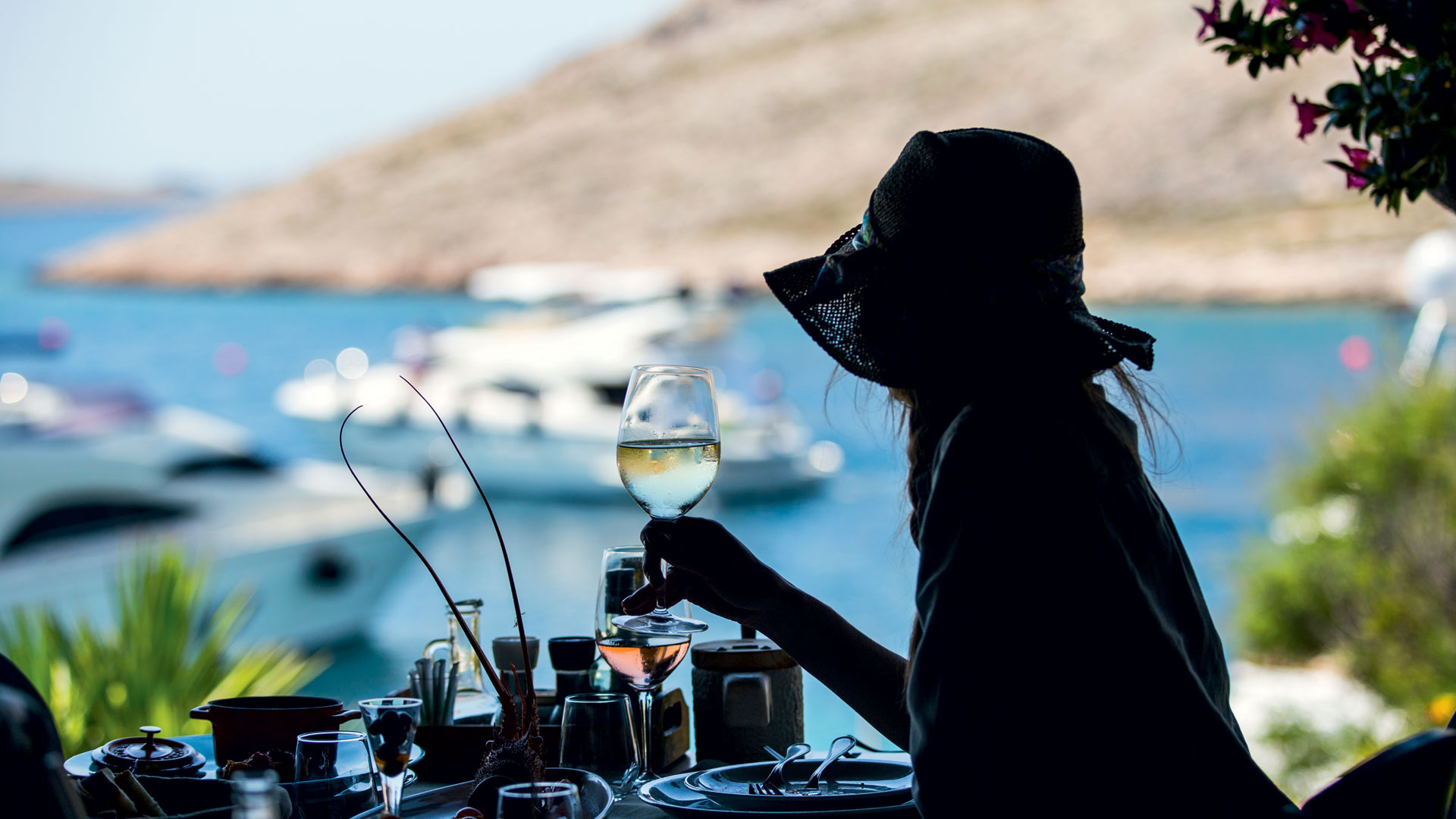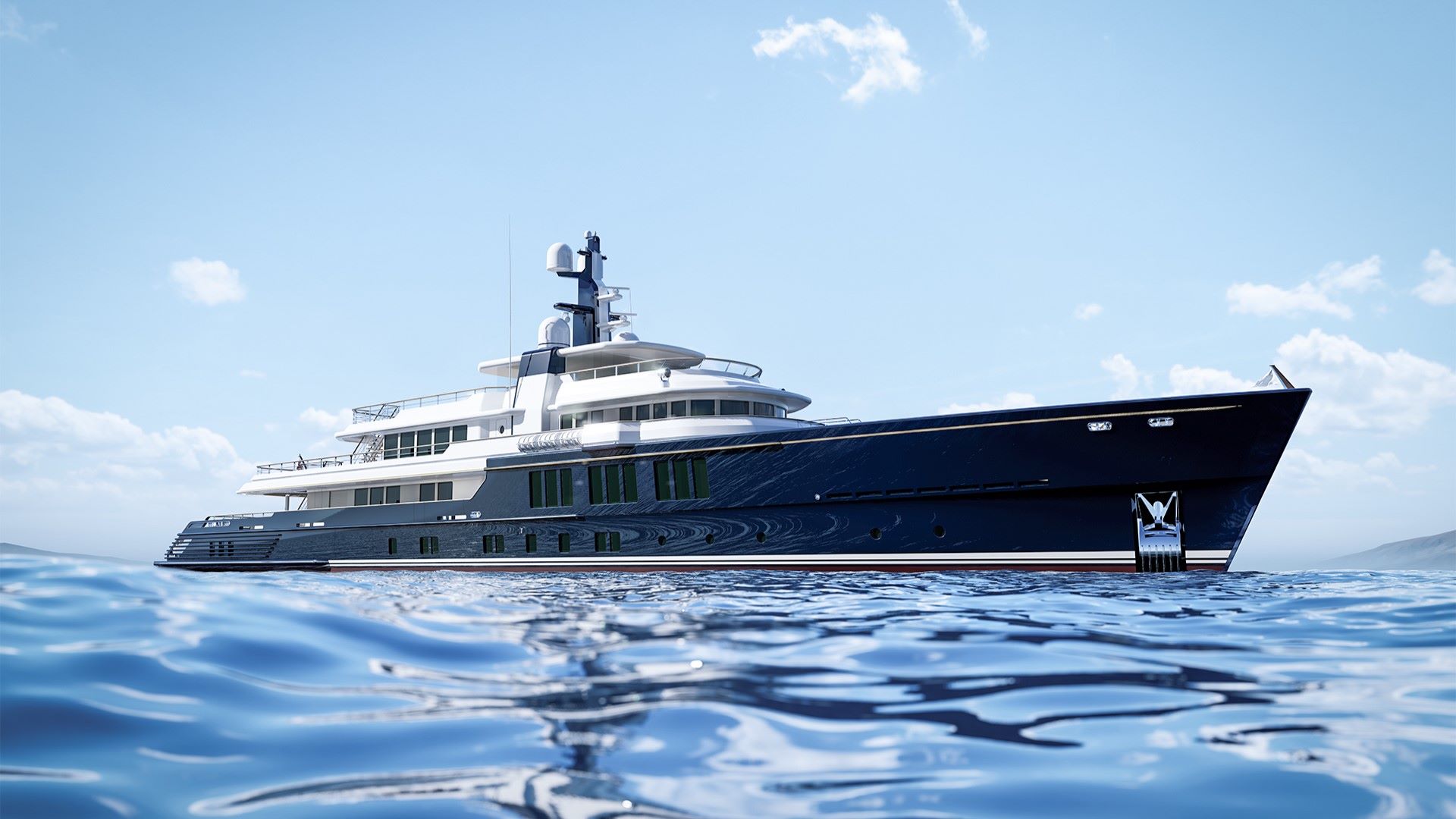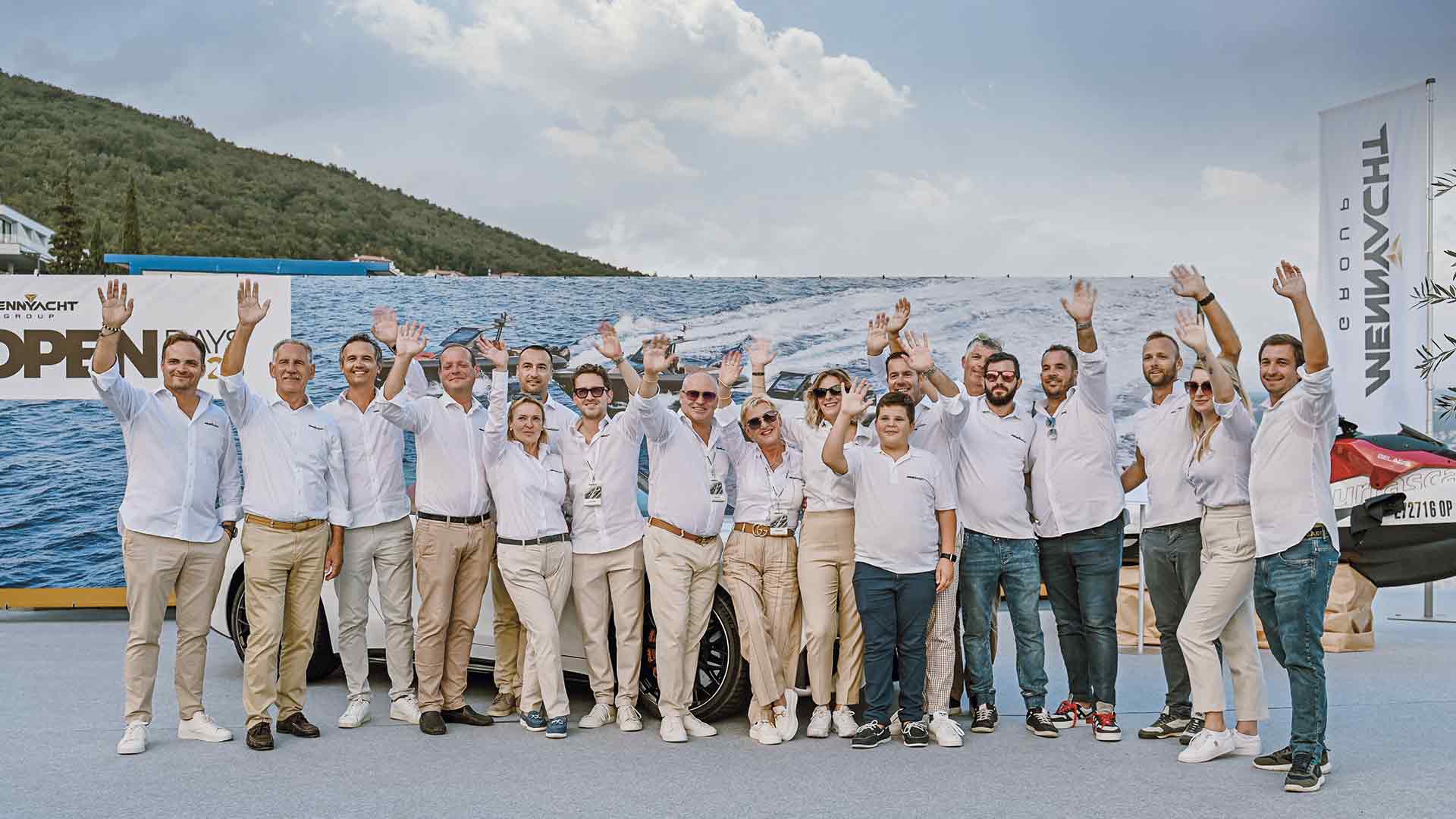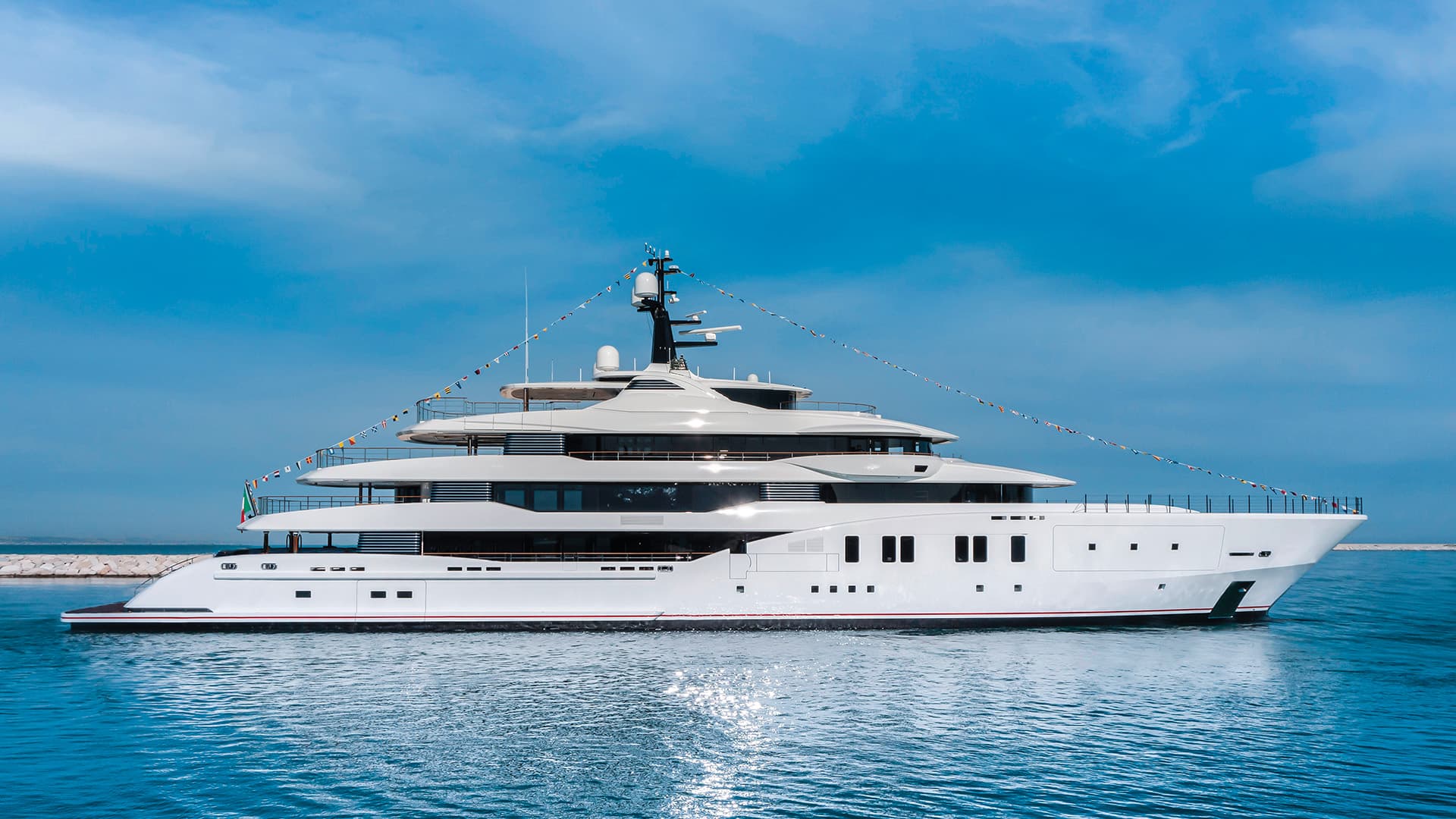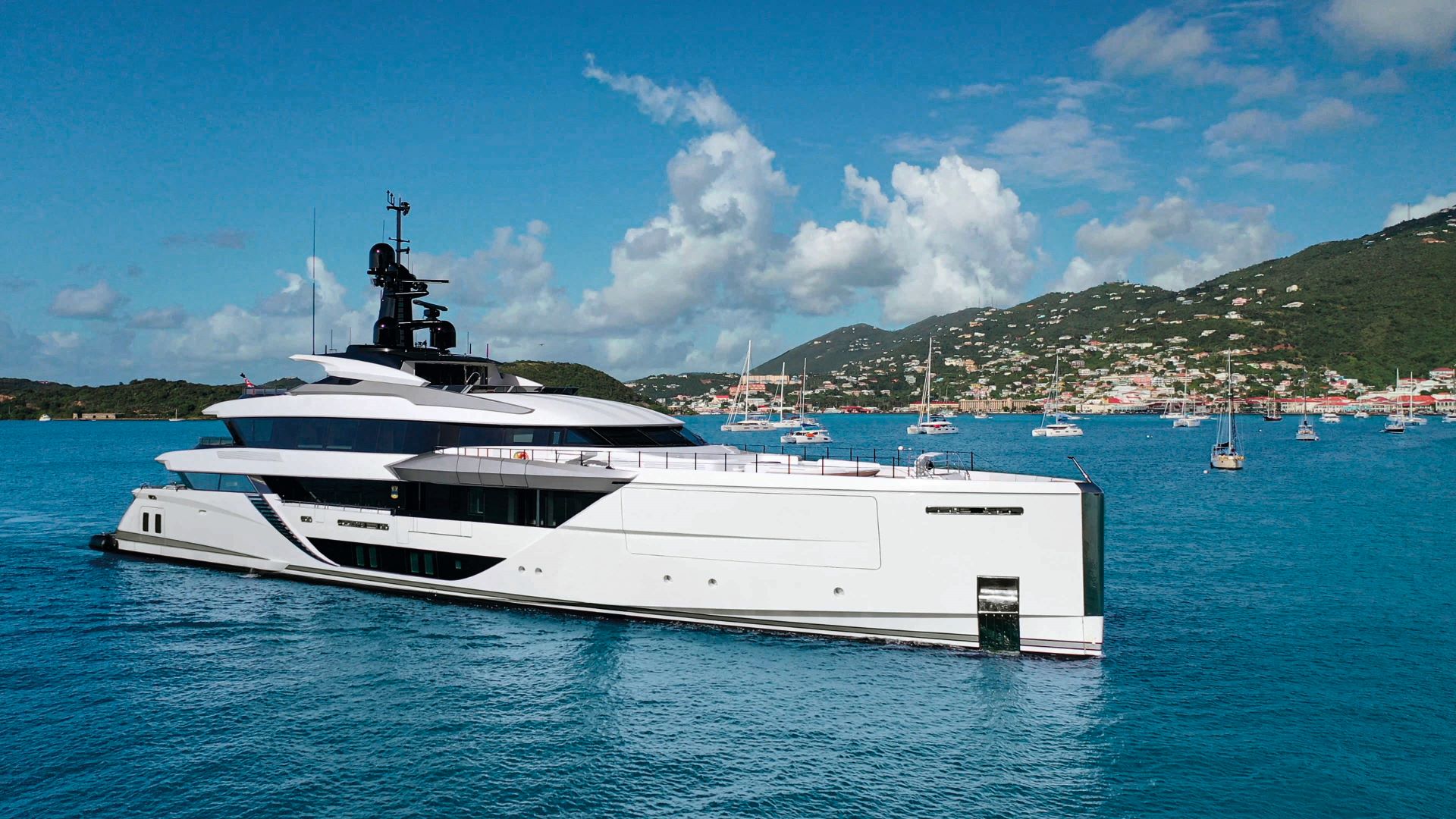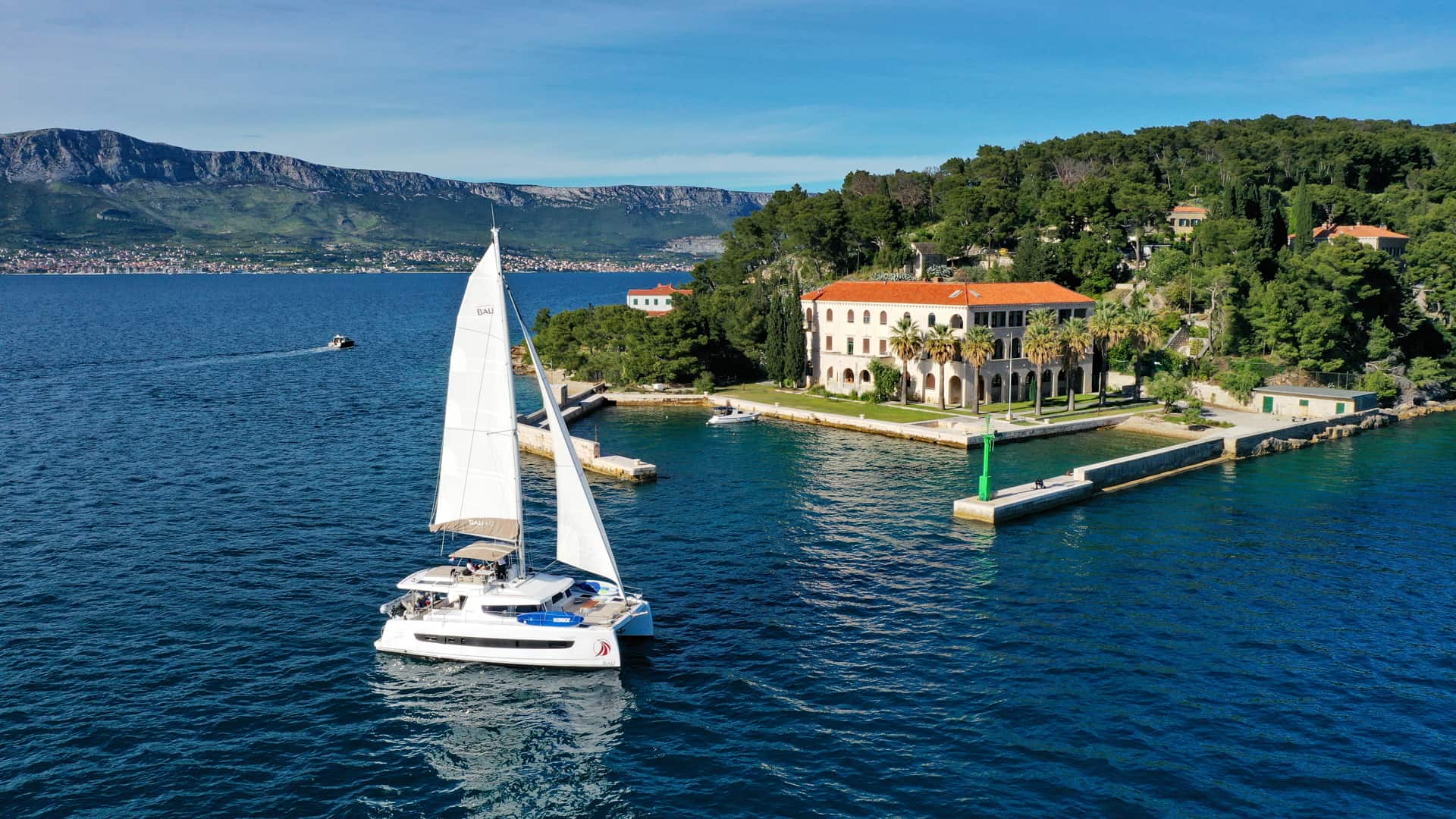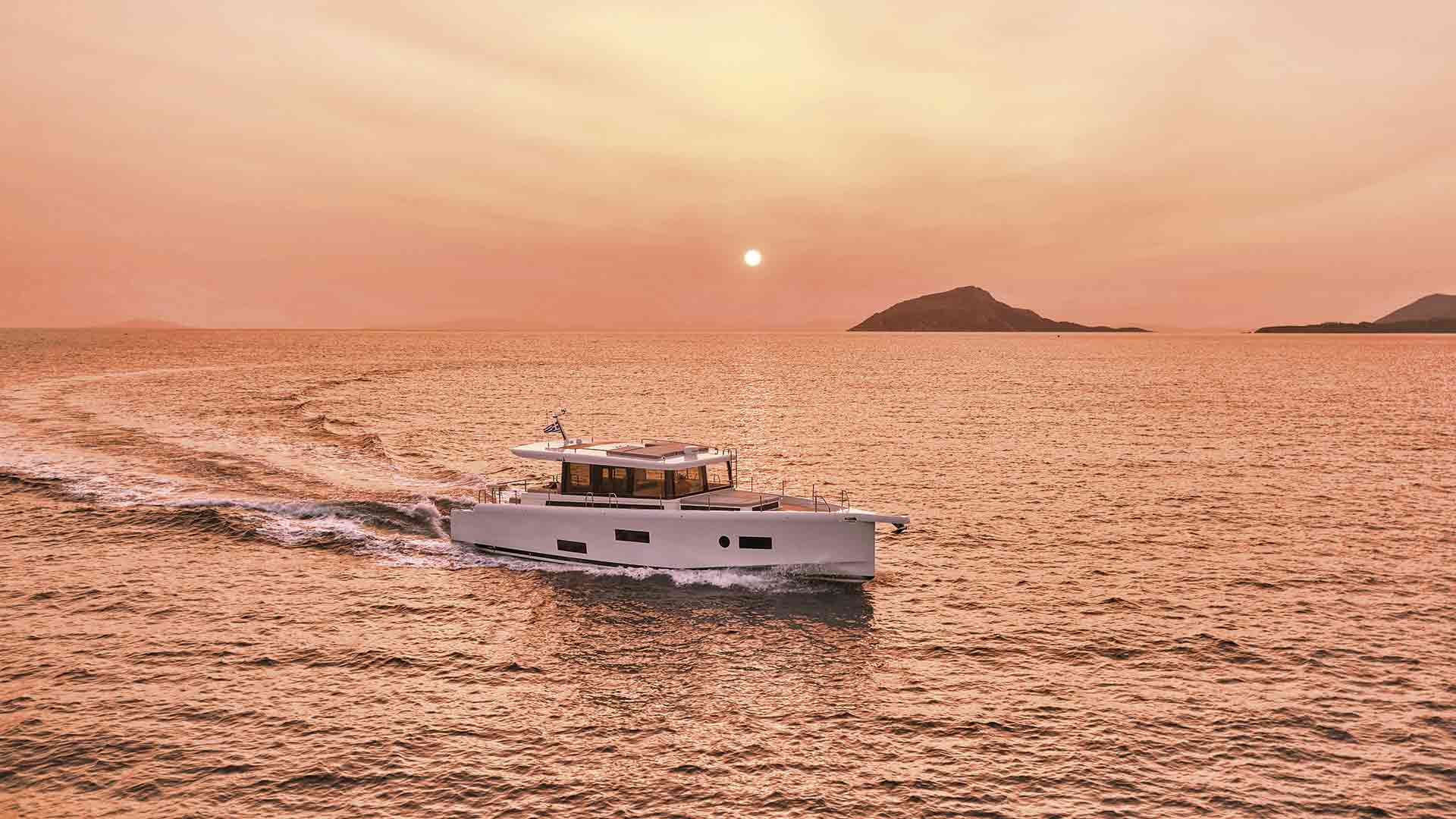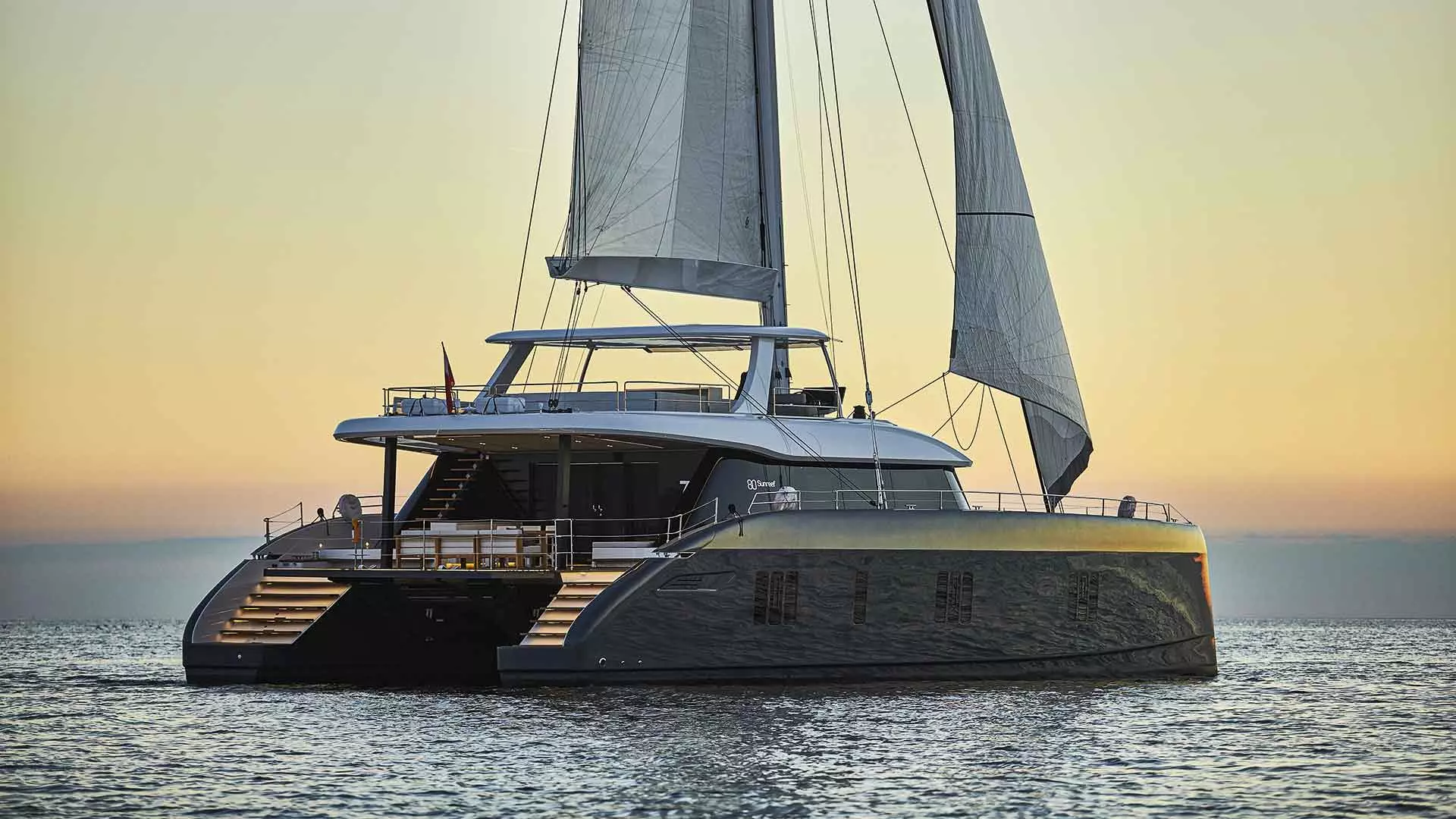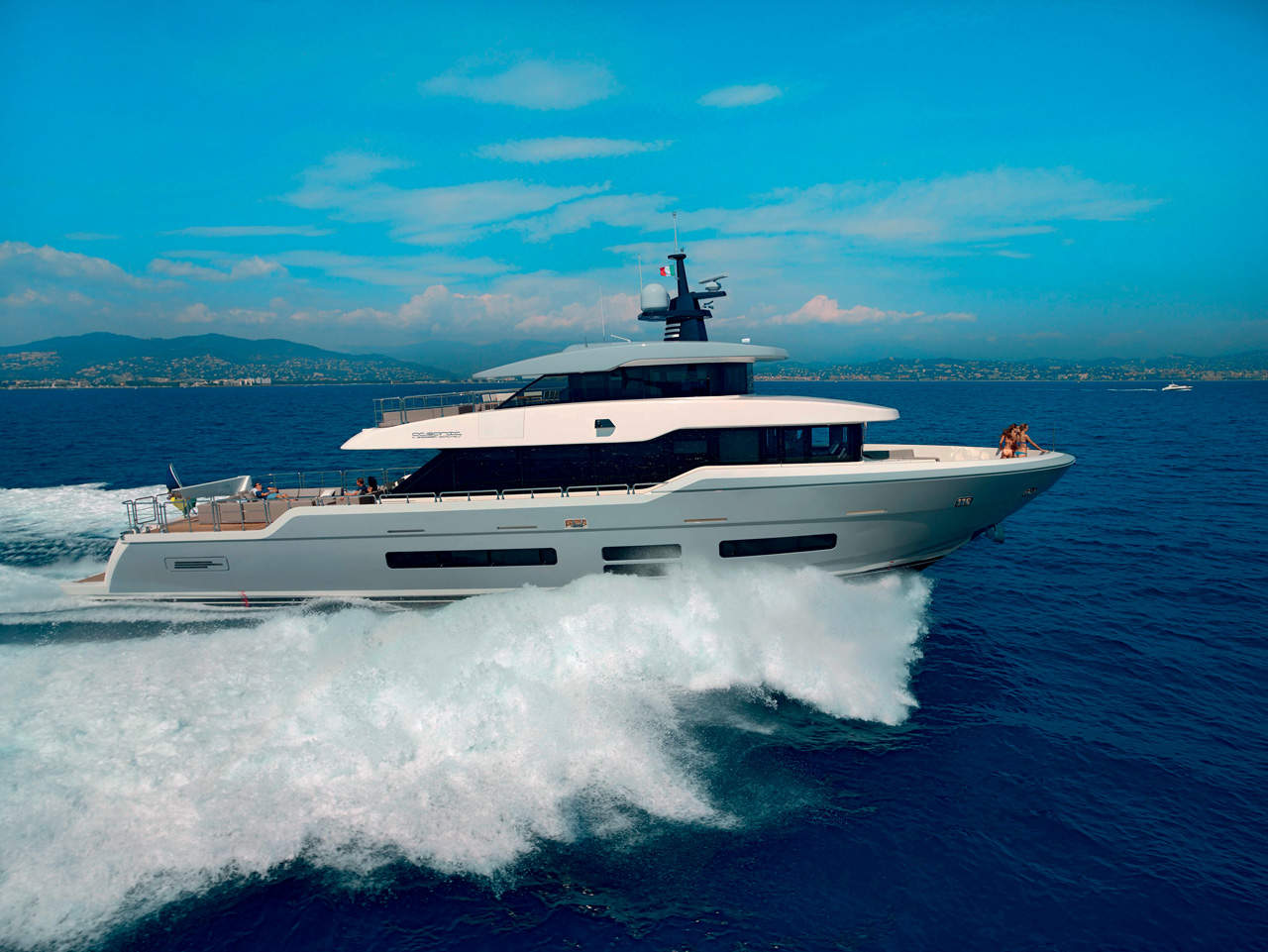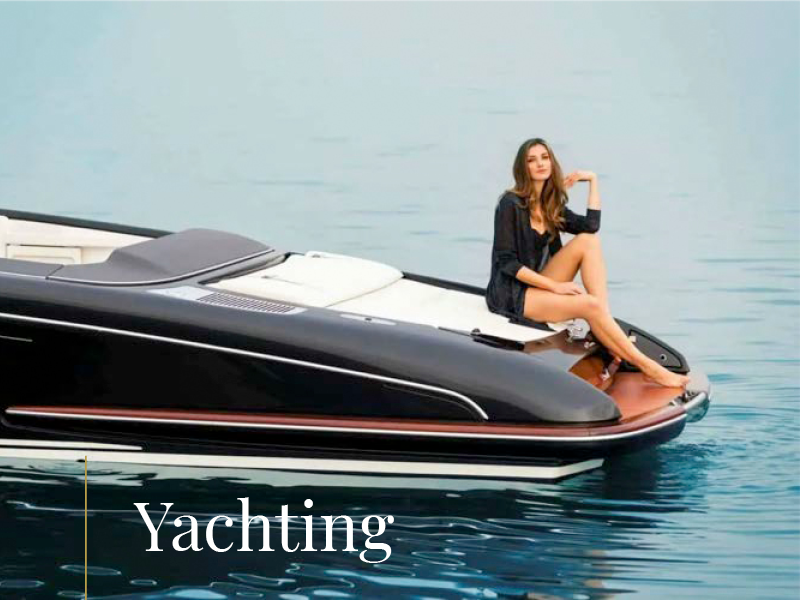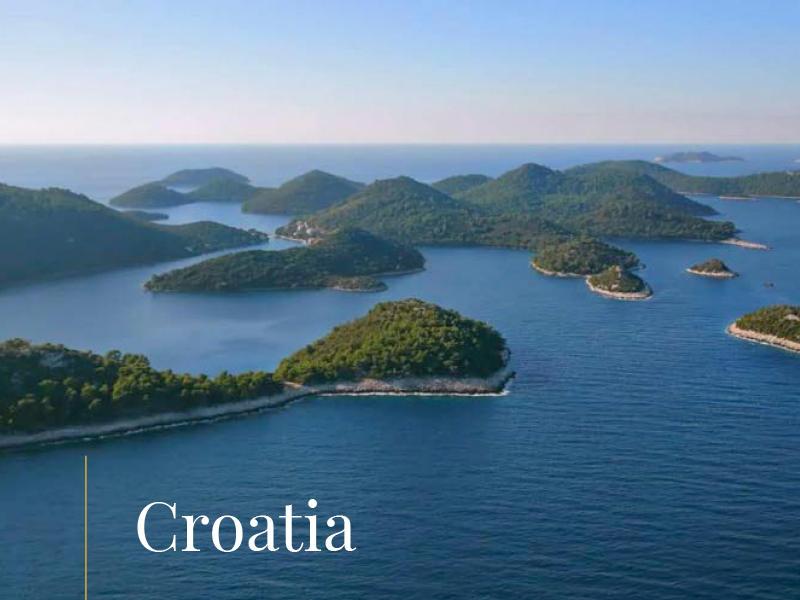CRN Atlante is a distinctive yacht designed by Nuvolari and Lenard that demonstrates the Italian yard’s expertise in tailoring vessels to the individual personality of each owner
The most popular photograph currently available of MY Atlante is a dramatic image captured with split second timing during an electrical storm off the coast of Croatia this summer. In this opportune image the photographer encapsulates the one word we’d use to describe this latest 179’ (54.80m) launch by the CRN shipyard in Ancona, Italy: striking!
CRN Atlante exterior
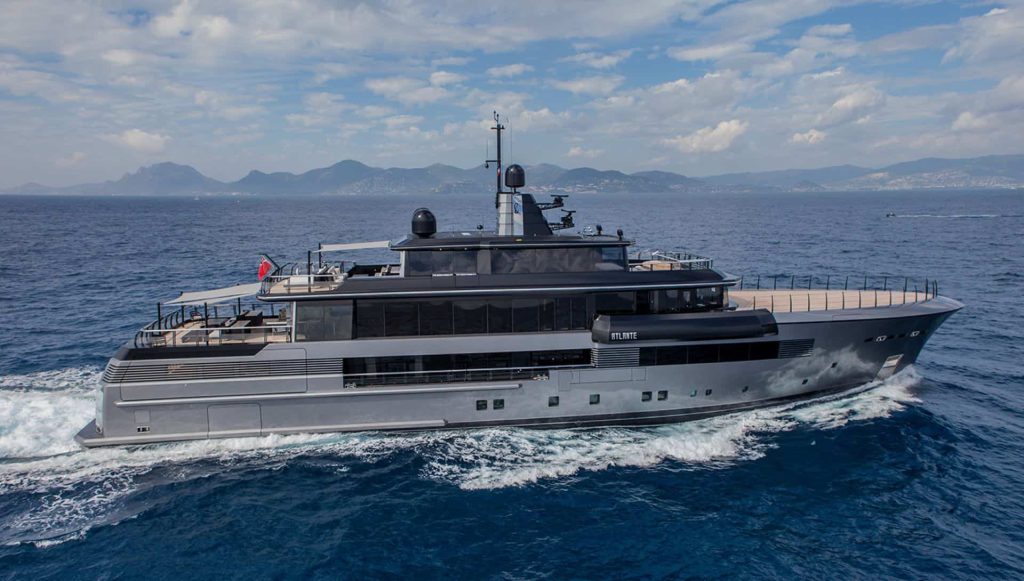
The yacht’s militaristic exterior lines, finished in a silver and matt black paint system by Dupont, were drawn by the eminently versatile studio of Dan Nuvolari and Carlo Lenard in Venice and certainly exhibit a persona that inclines more to the masculine than feminine. This is further borne out in the name the yacht was christened with, ‘Atlante’ being the Italian translation of the decidedly masculine mythological god Atlas.
Through the centuries yachts and ships have traditionally carried the female article in linguistic terms, leaving us grappling with a case of gender dysphoria when referring to MY Atlante. The unique and highly inventive nature of Atlante’s design provides further consternation when attempting to classify her in terms of yachting genre. Her imposing bow, masculine form, tender carrying capacity and range hints ‘Explorer’, yet as we’ll explain shortly, the concealment of practical equipment suggests otherwise.
Certainly not exhibiting the delicate elegance one usually associates with a traditional ‘white yacht’, CRN Atlante is the accurate translation of an individual’s desires and has been designed and built to accurately reflect the owner’s intended use and personal preferences.
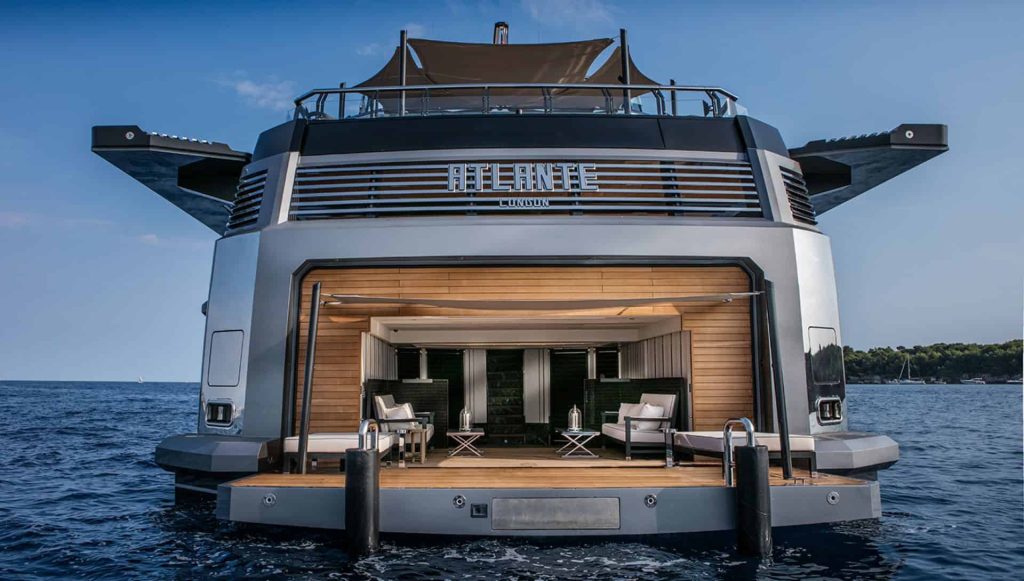
The facets of the angular exterior planes are reminiscent of a cut gem and personally we treasure the aesthetic for its uniqueness and the distinctive nature of the design. ‘The outer lines have been developed with a specific final look in mind,’ designer Dan Lenard tells us, ‘aggressive, but at the same time very proportionate.’
Lenard continues by explaining the challenge they faced in incorporating various elements: ‘This is a high-impact yacht, whose determined military look becomes soft on the sea. We had to find some original solutions, such as a non-traditional bow and areas entirely devoted to guests, like the side doors of the main deck that–once the tenders have been launched, can be exploited to the fullest.’
Atlante has the ability to remain a very private yacht
As we’ll see when exploring Atlante, the solutions incorporated into the yacht are highly original indeed! Our first encounter with Atlante in the flesh was at the Monaco Yacht Show in September, where she sat alongside another recent CRN launch; the 201’ (61.30m) MY Saramour delivered in 2014.
While Atlante’s sibling boasts a full 22’ (6m) of extra length, Saramour’s near identical Gross tonnage (1,024 and 1,080 GT respectively) demonstrates why the industry and media’s preoccupation with measuring yachts purely on length is something of a fallacy. Curiously, both yachts are built on the same beam, but one only has to take a moment to consider Atlante’s exterior to identify where the additional internal volumes have been created.
The enclosed aft area of her main deck is the most obvious contributor, but one should also take into consideration her high foredeck and the absence of lateral passageways on the bridge deck that ensures the sky lounge utilizes almost the full beam.
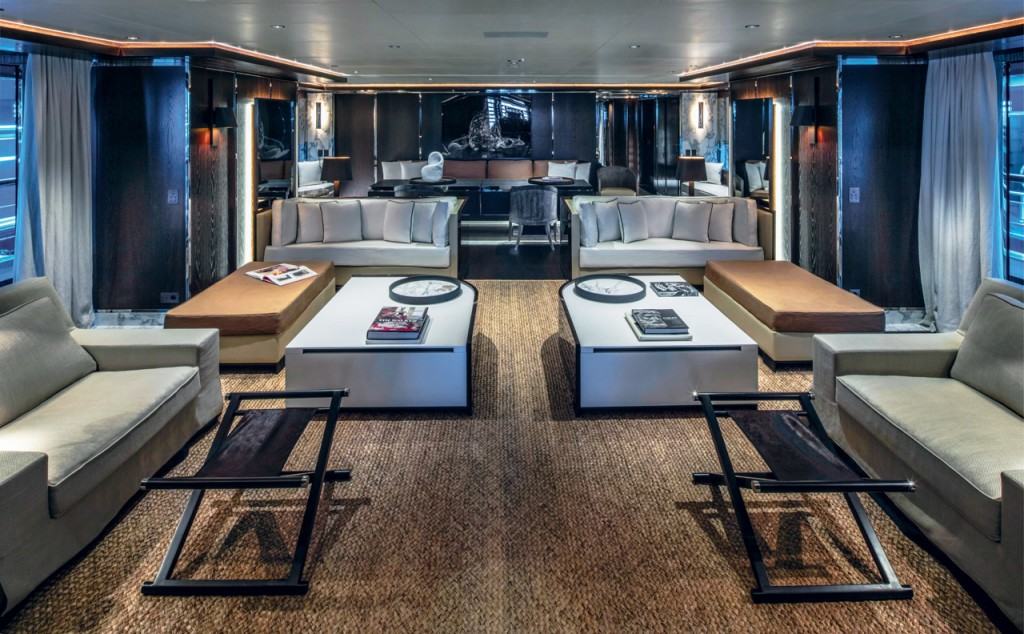
The high foredeck not only encloses the technical area and creates a vast exterior entertainment space forward–importantly redeeming Atlante from being criticized for a lack of external deck space–but also highlights the owner’s desire that no deck hardware, technical equipment, or indeed anything dedicated to operational use, should be visible. Take another look at the photographs, you’ll notice not one cleat, capstan, windlass, crane, life raft or even life-ring is visible; in fact, if it were not for the odd fairlead one could be forgiven for assuming the yacht was never intended to dock in port.
The extraordinary efforts undertaken in order to accommodate the owner’s aversion to practical paraphernalia has predictably impacted on the crew’s operation of the vessel. Viewing her berthed stern-to at the dock in Monaco’s Port Hercules we pondered upon the challenges faced by the crew during her berthing maneuvers; deploying lines blindly from mooring stations concealed within each aft quarter must take considerable coordination. The Captain confirmed this fact during our tour, admitting: ‘I joined the project after around a year and a half and on seeing the plans for the yacht I drew the shipyard’s attention to the aft mooring stations. I was really skeptical initially about the design.
However, over time we discussed the challenges and found solutions to solve any issues I had. It’s true that the berthing operation is different and requires some prior preparation as we have to pass lines up to the upper deck, but with my Chief Officer up there and using one radio with an open channel for conference between the crew we have the operation dialed in now. Like anything else, with enough practice you become proficient and it seems like second nature.’
CRN were the first shipyard in the industry to incorporate a central staircase from the beach club directly into the main salon–aboard the Zuccon-designed Chopi Chopi–but on ascending the stairs Atlante revealed the first of her many surprises
Presenting an apparently impenetrable wall to the dock, there’s no doubting CRN Atlante has the ability to remain a very private yacht even in the busiest of marinas. If one is able to unlock the secret to securing an invitation onboard however, the whole aft section whirrs, clicks and transforms to reveal a number of concealed points of entry. Down from the upper deck the passarelle extends like a never-ending drawbridge, the lateral main deck shell doors raise and 29’ custom tenders are lowered into the sea, a lateral gangway can be deployed when berthed alongside and the transom plate drops and then further extends–both high or low–thanks to an integrated letterbox transformer staircase.
Contemporary interior
Watching the spectacle literally unfold like a Rubik puzzle, we muttered ‘Open Sesame’ under our breath and prepared to enter the mysterious yacht to discover what treasures lay within. When berthed stern-to, Atlante’s Beach Club area proves to double as an impressive and welcoming reception area. The teak-laid platform created by the lowered transom plate continues seamlessly into the Beach Club, the flush nature of the deck being a conscious design feature that proves to be highly effective. Ducking into the shade of the temporary Bimini strung between removable carbon fiber poles, we settled on one of two day beds that flank the bathing platform to remove our shoes.
Welcomed onboard by CRN’s Project Manager who oversaw Atlante’s construction, we were led into the cool confines of the Beach Club.
Dressed in smoked oak, brushed fir, teak and dark grey Carnico marble, we already begin to get a sense of the contemporary interior realized from a design by Patrick Gilles & Dorothée Boissier’s creative studio in Paris. We also begin to get a taste of the luxurious appoints we can expect onboard Atlante, for the well-equipped Beach Club features custom-made tables in the reception area before one arrives at two symmetrical areas of relaxation and rejuvenation: the right-hand one is devoted to relaxation, with a massage bed and a Turkish bath, while the other one on the left-hand side is dedicated to fitness, with Technogym equipment.
Terraces lower over the sea to serve both port and starboard areas, opening up and further enhancing two already highly attractive spaces. The Beach Club does provide access to the engine room, but instead made our way up the Carnico marbledressed central companionway, through a watertight glass and stainless steel hatch to where one would usually expect to find the main deck cockpit.
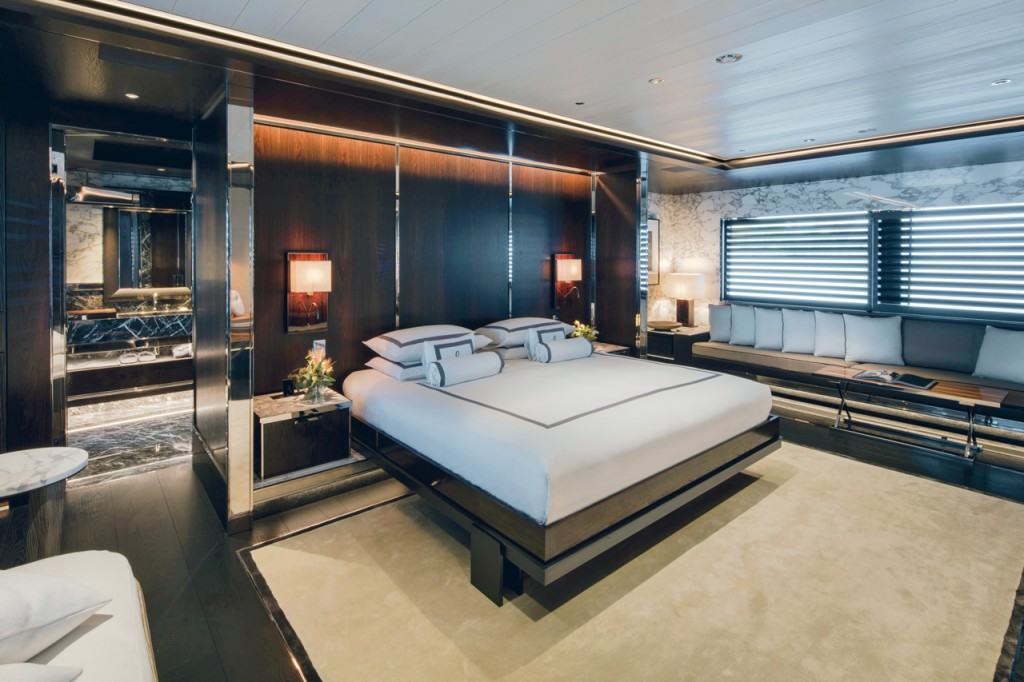
CRN were the first shipyard in the industry to incorporate a central staircase from the beach club directly into the main salon–aboard the Zuccon-designed Chopi Chopi–but on ascending the stairs Atlante revealed the first of her many surprises. Rather than an open cockpit, the aft section of the main deck is instead a fully enclosed space that’s primary function is the garaging of the yacht’s three tenders: two 29’ custom tenders built by Ici Yachts in Bergamo, Italy and a 16’ rescue tender.
CRN Atlante may be the first yacht interior created by the Parisian designers, but they certainly left no stone unturned. Everything, from furniture through to the fittings and lamps were designed by Gilles & Boissier then fabricated for the yacht as unique pieces
Once launched and recovered via the huge shell doors to port and starboard that rise like 30’ (10m) wings from the yacht’s hull–the area transforms into a private salon or semi-enclosed party area. Teak decking ensures durability for high traffic underfoot, louvered grille works wrap around to provide ventilation and overhead a drop down projector and speakers from Videoworks turns the space into a fun cinema area if so desired. In relocating the tender garage to the main deck in this manner, CRN and Novulari and Lenard have not only managed to create a dedicated beach club of dimensions one would expect on a considerably larger yacht, but also dramatically increased the vessel’s volume.
Inside Atlante main salon
Just a few years ago yachts of 164’ (50m) were generally built to remain below the 500 GT threshold, but in providing over double that in a 179’ fully custom yacht–and adhering to the costly additional requirements made by classification and regulatory bodies–Atlante proves there are owners willing to invest in building yachts that satisfy their requirements, rather than be distracted by cost savings or the lure of length. When we mentioned ‘fully custom’ in the preceding paragraph, we meant it in every sense and this is immediately evident upon stepping into the cool of the main salon.
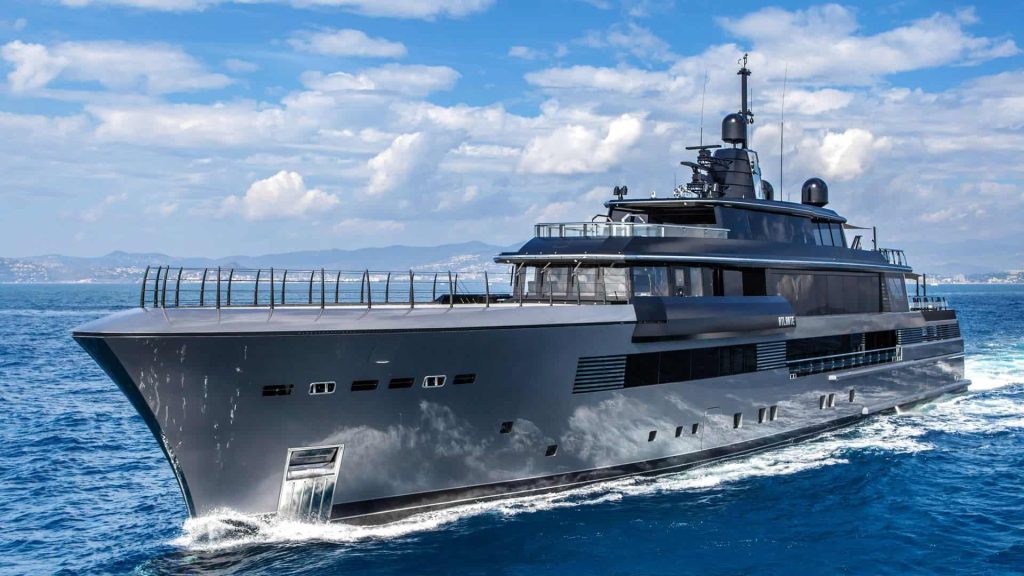
CRN Atlante may be the first yacht interior created by the Parisian designers, but they certainly left no stone unturned. Everything, from furniture through to the fittings and lamps were designed by Gilles & Boissier then fabricated for the yacht as unique pieces. Glass doors that open onto the lateral passageways define the aft lounge section of the salon, while large picture windows continue down its length to ensure generous provision of views and natural light. Taste is obviously highly subjective and with the owner being an established client of the studio one must assume the designers addressed his personal preferences. There’s much to like in the design, with a rich collection of textures and natural elements in the leather headliner, abaca fiber rug, marble and wood creating a warm, comfortable and tactile environment.
Included are tables made from fabric, wood and marble with metal legs; sofas with rosewood frames and light Loropiana fabrics; plus a truly marvelous solution in the forward section that addresses our aversion to the space usually devoted to (or more accurately, wasted on) a rarely-used formal dining area. An aft facing sofa is positioned against the forward bulkhead and is served by low coffee tables that sit on an inset Tai Ping rug. Being adjustable however, when raised to their full height a full dining table is formed and with freestanding chairs provides covers for the full complement of guests aboard. If there is one element of the interior design that failed to resonate with us, it was the proliferation of glossy dark smoked oak used throughout the yacht.
Novel and practical
Again this is subjective and it can be argued that it lends an atmosphere of warm comfort, but while it may suit the confines of a dim cigar lounge or gentleman’s club, one feels its dark gravitas is somewhat misplaced in the yacht sector where a light and airy ambience is more appealing. This issue is perhaps most noticeable in the starboard guest lobby where one finds the elevator that serves all decks–including the sun deck–and the central staircase with its treads of white Carrara marble subtly lit to highlight the delicate grey veining.
Proceeding forward we pass a day head finished in Calacatta Vagli marble and afrormosia teak and enter a suite of staterooms that comprise the on-deck master. The long sofa that runs the length of the starboard side is served by a pouffe and table, both of which slide along a rail to address the position chosen by the occupant, it is a solution that proves both novel and practical.
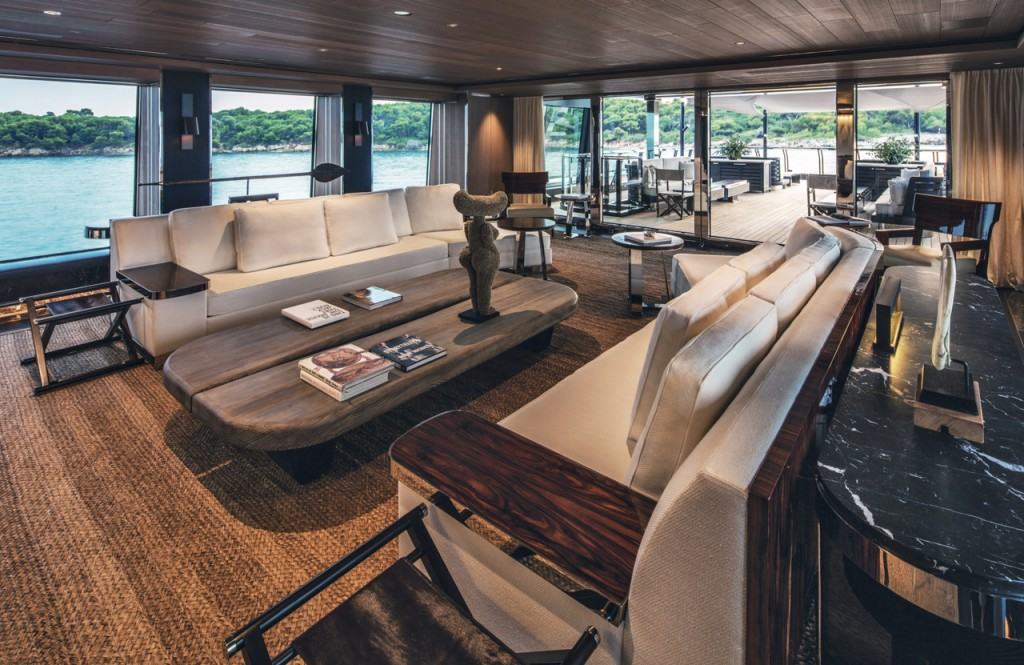
The marble lined corridor then opens into a full beam master cabin that displays the varied palette of wood species used onboard: brushed silver and brown fir, brushed black oak, eucalyptus for the desk and coffee table, and leather panels. Bright stainless steel accents lighten the ambience, but the profusion of marble in the cabin and dark grey Carnico-lined full beam en-suite makes a considerable contribution to the yacht’s deadweight, even when honeycombed. Our inspection of the guest accommodation on the lower deck revealed not the four symmetrical cabins one has come to expect, but instead four VIP’s of varying size and layout.
This individuality is a factor we really liked and though similarly finished in terms of materials and custom furniture, each possesses its own character. The aft portside double is the largest of the four on offer and unlike its neighbor to starboard has an en-suite to buffer the aft bulkhead shared with the engine room, but the forward twin to port was perhaps our favorite. Incorporated into the oversized single berths are an iPhone and iPad docking station, useful for both regular personal use and control of the environment and AV system thanks to integration with the Videoworks system via an App personalized to the yacht. Further forward on the lower deck is the crew accommodation, where not only does the Captain enjoy a generous berth, but his charges have full use of a mess and direct access to the galley and all decks via a companionway on the portside.
As CRN has distilled their mega-yacht expertise and experience in the build of this pocket cruiser, Atlante stands on the shoulders of giants and epitomizes the definition of that metaphor in surveying future horizons and discovering truth by building on previous discoveries
Another useful addition for crew, and one rarely found on a yacht of Atlante’s size, is a provisioning and service door in the portside hull. In fact, making the life of the crew easier is something of a feature of CRN Atlante; for example, the wonderfully heavy venetian blinds in the guest accommodation are mounted in moveable frames, so rather than stretching behind to clean they can be simply moved aside. The devil is in the detail! Heading up to the upper deck we found the Captain in the wheelhouse and after discussing the challenges of berthing (detailed earlier), we enquired regarding his favorite features of the yacht? ‘The owner’s taste and my own is really quite similar, so the overall styling suits me very well, but the configuration of the flush deck of the bow has to be my favorite feature of CRN Atlante. I like clean lines–in terms of sight and design–and features like the concealed dining table are really innovative in ensuring both.
The covered technical area allows the crew to work in a protected space, and it creates both a 46’ long expanse of teak and huge volumes for storage– we have three jet skis, two SeaBobs, plus all our supplementary gear hidden away under there.’ The generously proportioned wheelhouse features tried and tested systems integrated by Telemar and while the Captain elected not to request Dynamic Positioning System for the main yacht, the two custom tenders with pod propulsion do; another crew bonus. Moving out on the foredeck we discovered just what the Captain was alluding to, not one piece of technical equipment is visible on the foredeck and freestanding deck furniture can be arranged on the vast expanse of teak as guests require.
Wonderful spa pool
The real surprise however comes when, at the touch of a button, a Japanese style dining table concealed in the teak deck that rises up foot or so; leaving the option of guests sitting either cross-legged on the deck or with their feet in the well below. We love this feature and given imitation is the most sincere form of flattery, expect to see it replicated on many yachts in the future. Another interesting feature of the foredeck is the sculpted form of the curved carbon fiber stations that support the sail yacht style cable guardrails. An attractive aesthetic solution that has the added practical benefit of being easily removable as the deck can also be used as a touch-and-go helipad. Passing by the upper deck lobby with its two sole-to-ceiling picture windows and a large hollow wooden artwork that frames panoramic views, one passes into the upper deck salon.
As one can see from the exterior and interior images, the aft section of the upper deck features enormous expanses of lateral glazing, creating a true sky lounge in every sense of the phrase. Bedecked with tactile natural elements that engenders an eminently relaxing atmosphere, the uninterrupted communication occupants have with the world outside continues courtesy of the 20’ (6m) wide glass door that slides back to open out onto the aft deck. Acting as both an informal dining and relaxing area, the terrace also doubles as a reception area for guests boarding via the colossal passarelle. Cool drinks served at the wet bar ensure their time onboard commences in a suitably refreshing manner.
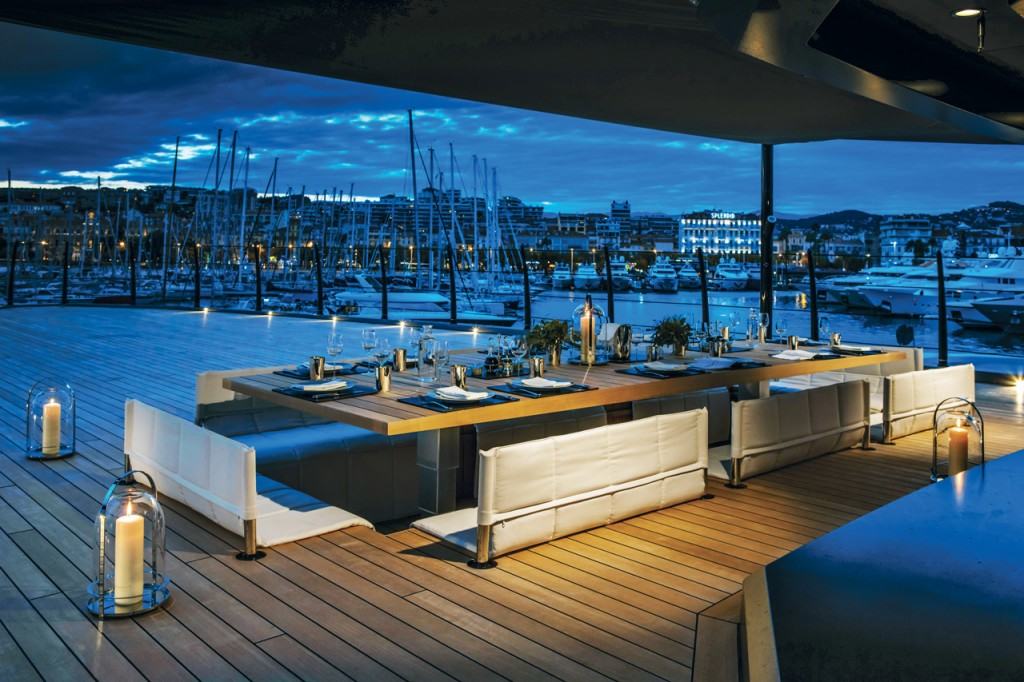
Taking the open tread staircase up to the sun deck, which can also be accessed internally via the staircase or elevator, one proceeds to a space dedicated to repose, rejuvenation and recreation. Deeply cushioned sunbeds and sofas invite guests to sink in with a drink and a book, while another convertible cocktail/dining table allows for informal al fresco entertainment and dining. Throughout the yacht temporary and electronically actuated sunshades and biminis provide respite from the heat and further forward of the central stack that contains the elevator and technical spaces, lies a party-sized sunpad and a wonderful spa pool fashioned in stainless steel and glass. If there’s a better place onboard to relax at anchor or in port with a martini and loved one, we failed to find it.
Yacht that polarize opinion
It is probably fair to say that CRN Atlante is a yacht that will polarize opinion. Those who prefer the graceful sweeps and arcs of more traditional designs may not warm to her entirely and the number of original solutions she proposes will certainly defy those who try to pigeonhole her. But the fact is we like her very much because, not despite, of these very factors. Atlante is totally unique, creatively considered and innovative in her use of space. In extracting 5,600sqft (520sqm) of interior guest space, over 5,000sqft (470sqm) of internal and external teak decking and 1,150sqft (107sqm) of crew quarters–all from a 179’ (55m) footprint, CRN and designers Nuvolari and Lenard have performed something of a miracle.
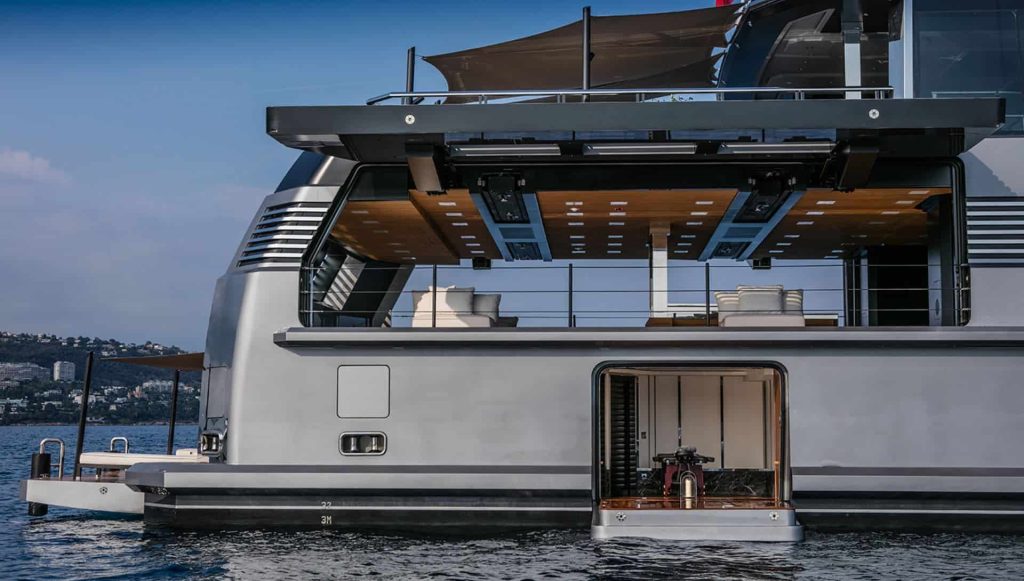
True Atlante has her foibles, like the convoluted berthing procedure, but much attention has been devoted to making the crew’s life easier elsewhere. Some may lament the loss of a cockpit, but the versatile space created instead offers numerous benefits: not least the ability to launch and recover her tenders in sea states that would be unsafe for yachts with garage shell doors just above the waterline to do so. In fact, it is factors like this–along subtle features like her well-protected glass enclosed lateral passageways and–that convince us Atlante could be developed into a true world explorer. Personally we’d upgrade the hull to Ice Class, perhaps tone down the militaristic styling so as not to alarm the natives of remote regions, slightly extend the 3,100-mile range provided by twin CAT 3512C engines and add an on-deck fire pit… then sit down with our Captain and plan an extensive circumnavigation.
As CRN has distilled their mega-yacht expertise and experience in the build of this pocket cruiser, Atlante stands on the shoulders of giants and epitomizes the definition of that metaphor in surveying future horizons and discovering truth by building on previous discoveries. Having met a number of megayacht owners looking to downsize, we look at Atlante in a new light; a shining example of what can be achieved within a modest footprint with creativity and imagination. Atlas may have carried the world on his shoulders, but we’d certainly be happy to explore the world if carried by Atlante.
Photos Maurizio Paradisi & CRN Yachts
Video CRN Yachts
